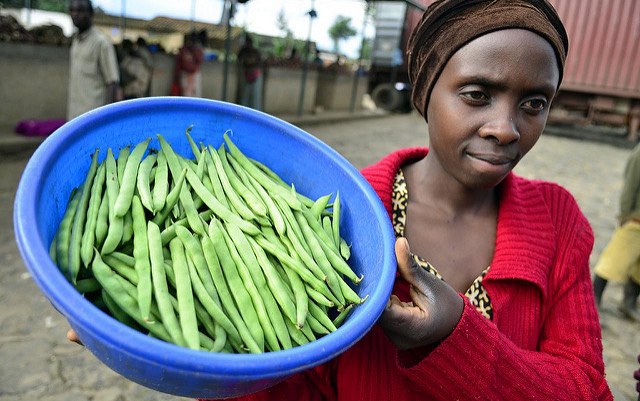This blog post is the first in a 3-part series accompanying the release of the book Agriculture for Improved Nutrition: Seizing the Momentum, co-edited by Shenggen Fan, Sivan Yosef, and Rajul Pandya-Lorch (co-published by CABI Publishing and IFPRI). Read part 2 here and part 3 here. The book will be launched at a Feb. 28 event at IFPRI headquarters in Washington (for more information or to register to attend, click here).
It is the single most important innovation in human history. Over the course of thousands of years, agriculture has staved off hunger, allowed populations to leave their hunter-gatherer lives behind, and freed up time for other pursuits (like inventing writing and the wheel!) that have propelled societies forward. As recently as the 1970s, the Green Revolution, a global push to improve and produce more wheat and rice, brought India back from the brink of mass famine. The Green Revolution improved the lives of 1 billion people around the world. This number is all the more impressive considering that the world population was 4 billion at the time.
But for all its achievements, our current food and agriculture system is falling woefully short. In 2017, 821 million people were undernourished. About 151 million young children under 5 were stunted, or too short for their age. One third of women were anemic. And the global obesity epidemic shows no signs of stopping.
Malnutrition does not just affect health. Children who are undernourished when they are young end up starting school later, don’t complete as many grade levels, and also earn less income as adults. Worse yet, these statistics translate into misery for people who do not even exist yet: Poorly-nourished women give birth to poorly-nourished children, perpetuating a downward cycle.
Why does agriculture—in practice, in study, in government support and development programs—so often fail to consider nutrition? After all, it seems obvious that good food is needed for good health. To be fair, for millennia, the main responsibility of agriculture was to avert food shortages so that people did not starve. In the midst of such emergencies, food quantity has seemed more critical than food and diet quality. This is the type of attitude that shaped the work of scholars and development practitioners for years, despite a steady growth in agricultural production to feed more and more people.
In the 2010s, the development community, building upon efforts by CGIAR, HarvestPlus, and others, began to engage and reach a critical mass on a different type of thinking: What if the enormous potential of agriculture to improve nutrition could be unleashed, in all possible ways? Agriculture, after all, does not just produce crops. It employs a huge segment of the poor population (almost 70 percent of people in poor countries), generating incomes that they can spend on healthy food, or doctor visits, or education. When women participate in agriculture, it can increase their power over income, land, livestock, and it also gives them a say on how food is distributed within their homes. Agricultural policies also affect consumers’ choices. For example, when a government provides subsidies for producing rice, that policy makes rice cheaper and incentivizes shoppers in supermarkets to buy it instead of, say, fruits and vegetables.
During the past decade, researchers, policymakers, and people working on the ground in poor countries have seized on this momentum to make significant advances in the small but mighty field of agriculture-nutrition. The results have been impressive. Some highlights include:
- China’s National Nutrition Plan now aims to produce nutritious and safe agricultural products. The country is also rolling out demonstration sites for researching nutritious staple foods like sorghum and millet. Many other countries have also been linking the two sectors together, including Peru, Rwanda, Uganda, and Vietnam.
- Biofortification, which increases the density of vitamins and minerals in a crop, is well on its way to reaching 1 billion people by the year 2030. Biofortification is ranked as one of the highest value-for-money investments for economic development.
- Many organizations, such as Action Contre la Faim and Welthungerhilfe , have also started integrating agriculture-nutrition links into their operational strategies, a big step in the right direction.
- In what may be the most visible recognition of the marriage of agriculture and nutrition, Sustainable Development Goal 2 , which aims to “end hunger, achieve food security and improved nutrition and promote sustainable agriculture” essentially combines agriculture and nutrition into one goal.
It is an exciting time to be a student or professional in the agriculture-nutrition field. Every day, researchers are producing more evidence on the agriculture-nutrition nexus. Leaders are calling on professionals to step out of arbitrary silos and work together. Capacity is being built up within people and institutions to carry out this work. These efforts will exponentially improve the design and implementation of programs and policies, helping to reshape the agricultural and food system, and achieve better nutrition for the world’s most vulnerable people.
Shenggen Fan is Director General of IFPRI; Sivan Yosef is a Senior Program Manager in IFPRI’s Director General’s Office; Rajul Pandya-Lorch is IFPRI’s Director of Communications and Public Affairs and Chief of Staff in the Director General’s Office. They are the editors of Agriculture for Improved Nutrition: Seizing the Momentum, published by CABI and IFPRI in Jan. 2019. This title will also be available as an Open Access eBook. This post also appears on the CABI blog.







